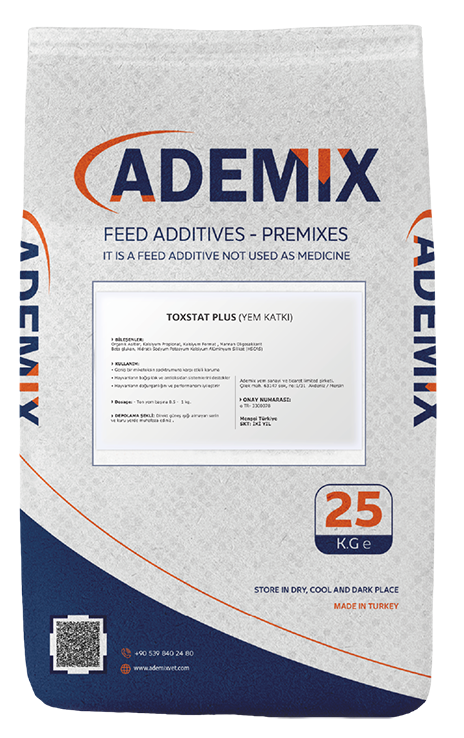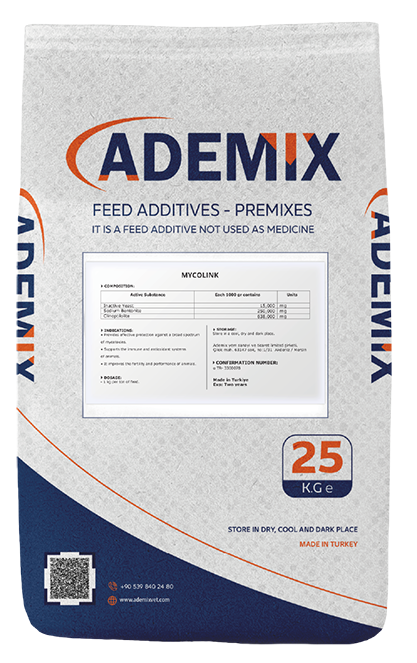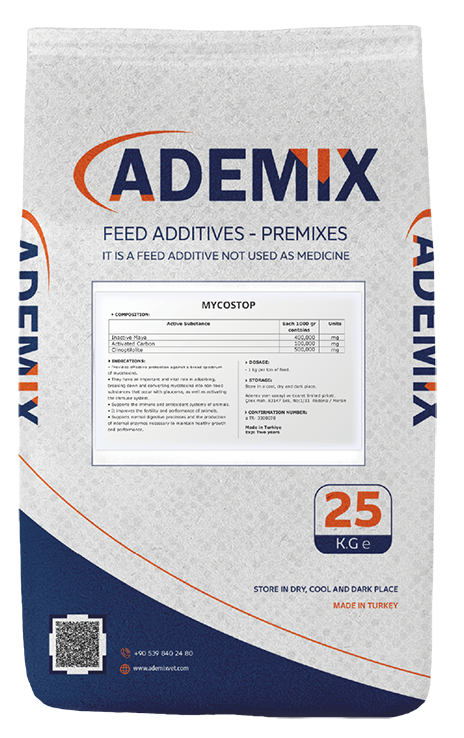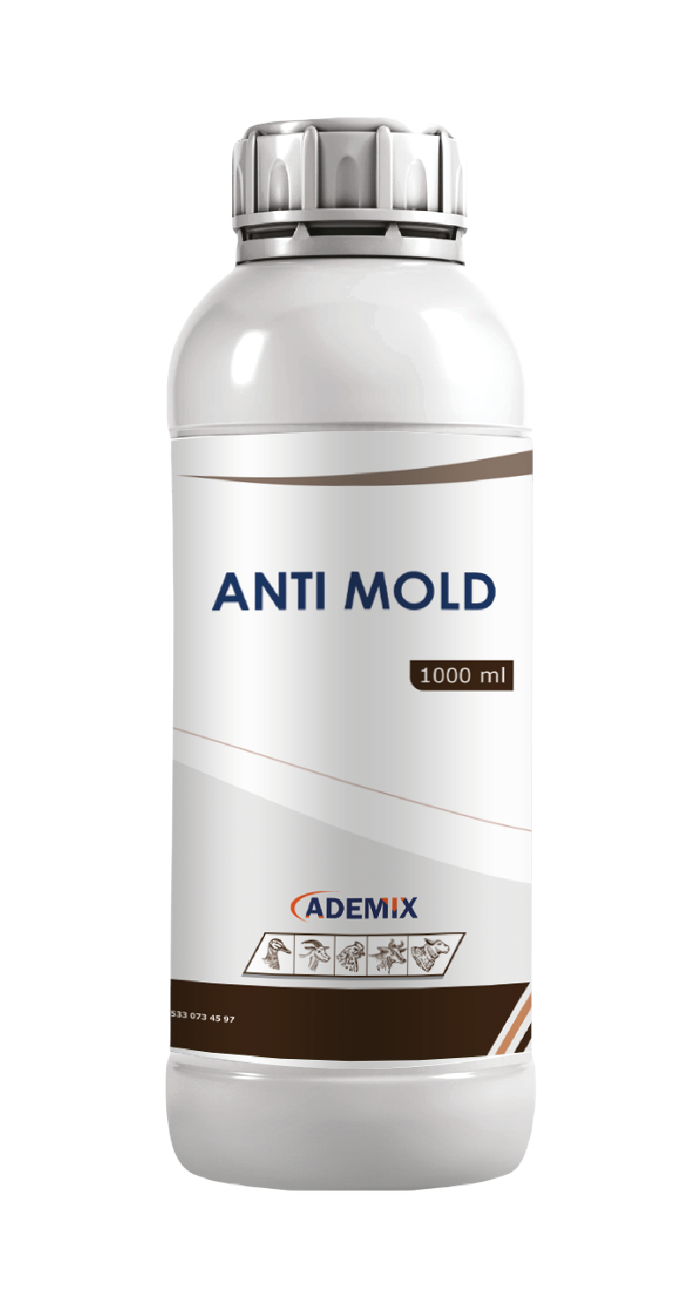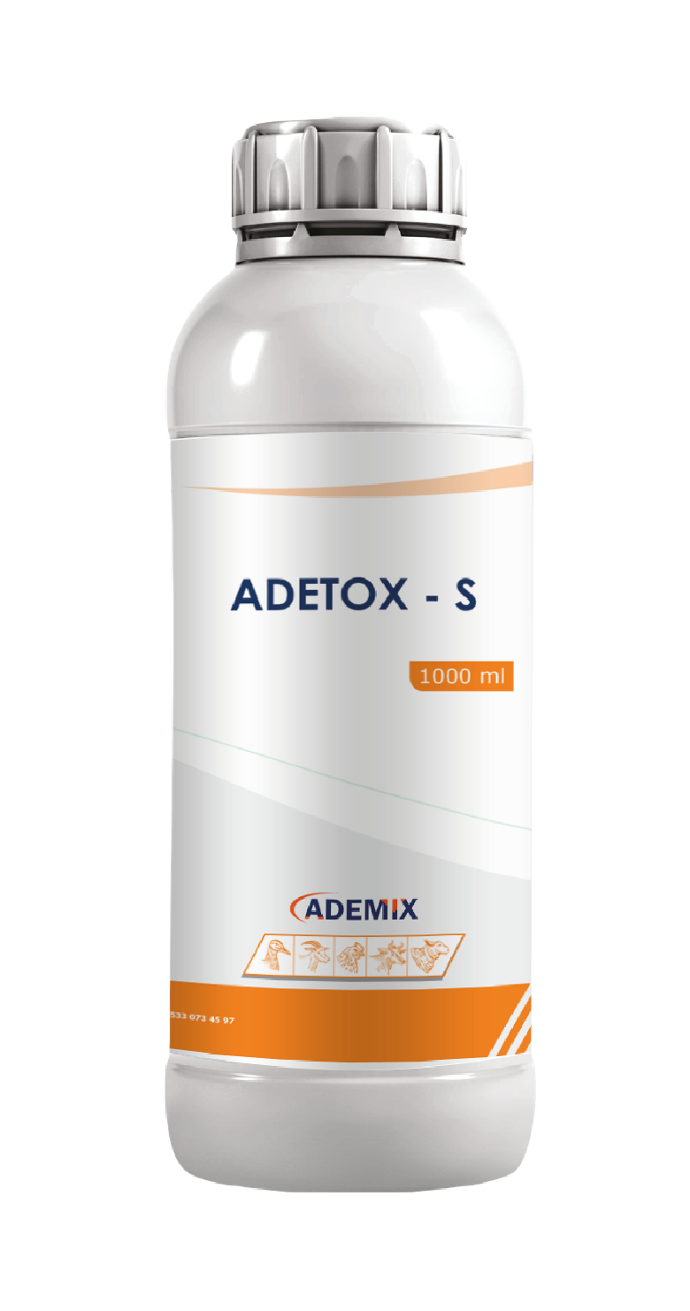Negative impact of mycotoxins on feed efficiency in poultry diet
- Definition of mycotoxins
- Types
- Effect of mycotoxin on feed efficiency
- How to deal with to decrease its effect
Content
- Synergism action of mycotoxins
- How to evaluate effective toxin binders in feed
- ADEMIX solutions for mycotoxins problem.
Definition of mycotoxin term
Mycotoxins are toxins that occur naturally, are generated by particular molds (fungi), and appear in food. They can be the source of various negative health effects and can be a significant health danger to livestock, horses, companion animals, and humans. Animal feeds assume a prominent part in the worldwide food industry as they make the production of commodities of animal origin globally. Farms or industrial feed mills can create the feeds in mixtures. The safety of the feed is a given for food security and personal and animal health. Similar to the production of food, feed production also involves in a quality assurance safety system.
Types of mycotoxins
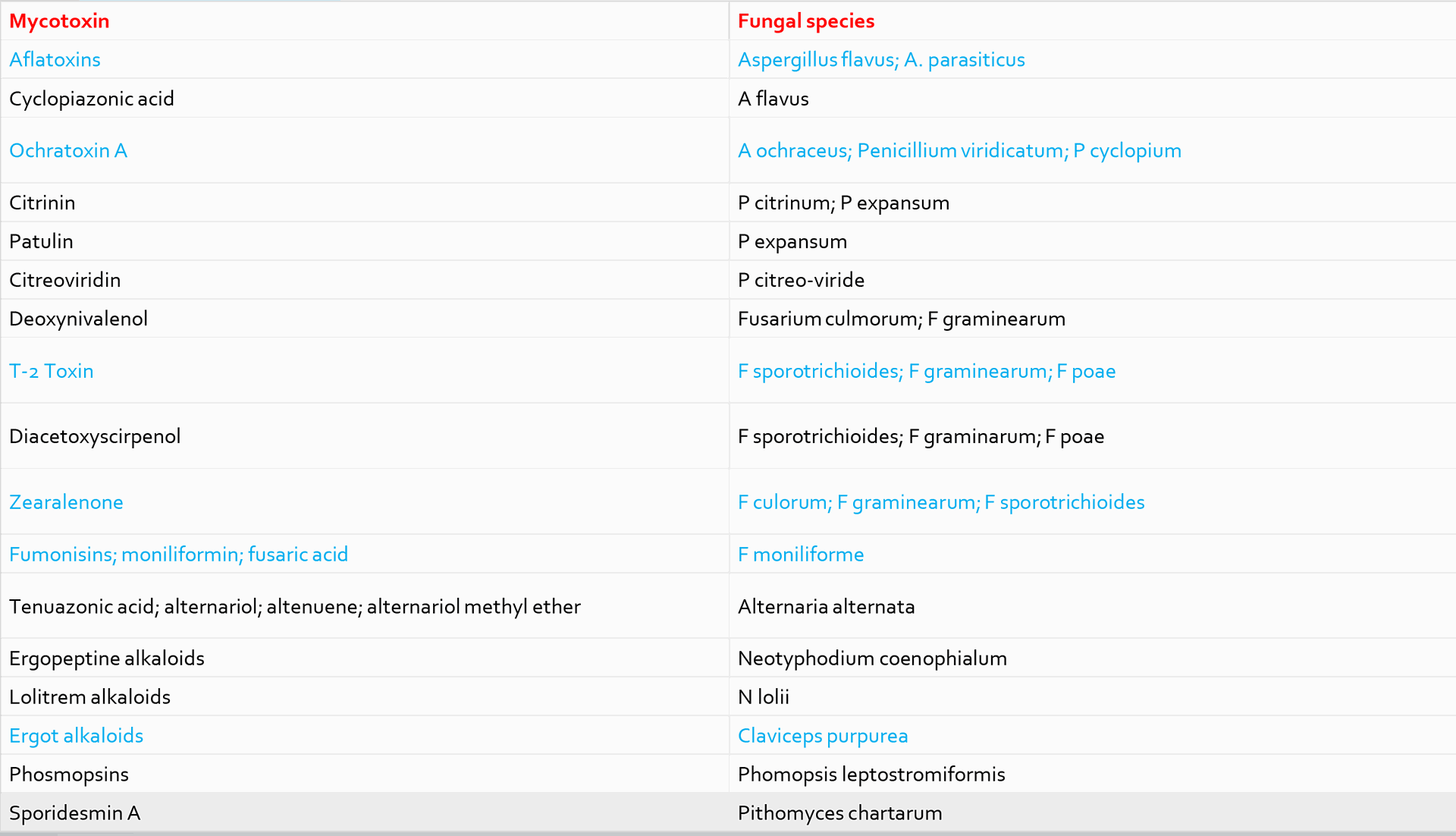
Key toxins produced by Aspergillus moulds:
Aflatoxin:
• Aflatoxins are of greatest concern in more tropical regions of the world where the climate is generally warm and humid – less so in colder, more temperate countries. Be cautious though if feed is being imported from tropical regions.
• Ducks are the most susceptible species to Aflatoxins, followed by turkeys, broilers, laying hens and quail. Aflatoxins are particularly toxic to the liver of poultry and will cause tissue damage and suppression of hepatic protein synthesis, which leads to growth rate checks and reduced egg production.
• Aflatoxins also inhibit lipid and pigment digestion in poultry by reducing bile salt production. Aflatoxins also interfere with vitamin D metabolism, which means bone and leg strength can be compromised. They can also weaken blood capillaries, which can increase the incidence of carcass bruising.
Ochratoxin:
• Ochratoxins are produced by different fungi and are found in temperate and tropical regions, with Ochratoxin A the most important. Ochratoxin A causes kidney damage in all poultry species, but can also cause fatty liver. Ochratoxin A is approximately three times more toxic to young chicks than Aflatoxin
Key mycotoxins produced by Fusarium moulds
Fumonisin:
Broilers and turkeys seem to be relatively resistant to the acute effects of fumonisins. However, research has shown that feeding contaminated feed with levels of up to 200mg/kg fumonisin B1 (FB1) leads to tibial dyschondroplasia in growing turkey poults.
Tricothecenes:
Poultry species are more sensitive to Type A Tricothecenes than Type B, but the occurrence of Type A in poultry feed is lower than Type B. Tricothecenes are irritants can cause oral lesions, dermatitis and intestinal irritation. The major physiological response to tricothecenes is loss of appetite, earning them the tag ‘feed refusal’ toxins, but they can also present Gut Health challenges too, increasing the occurrence of intestinal pathogens and diseases such as necrotic enteritis.
Effect of mycotoxin on feed efficiency
- Reduced feed consumption
- Poor growth rates
- Reduced egg production
- Reduced feed conversion efficiency
- Increased susceptibility to diseases
Common signs of mycotoxicosis in poultry include:
- Increased mortality
- Poor egg shell quality
- Reduced fertility
- Leg problems
- Carcass condemnation
Synergism
- Synergism between mycotoxins is defined as the toxic effect exerted by the combination of various mycotoxins at certain concentrations that is greater than the sum of the effects of each mycotoxin when presented individually (Gimeno & Lígia, 2011).
- In other words, synergism is when the observed effect of the combination of mycotoxins is more than what is expected based on the effects of each mycotoxin. When one or more mycotoxins do not induce an effect while the combination does have a significant effect it is called potentiation, although this term is rarely used (Smith https://et.al%2C/ 2016).
- Synergism increases the toxic effects of mycotoxins, and some of the synergistic actions are presented by aflatoxins with ochratoxin or aflatoxins with T-2 toxin (Greco, Franchi, Rico, Pardo, & Pose, 2014).
- In Fusarium-derived mycotoxins, most interactions range from additive to synergistic, affecting mortality, animal growth, and feed intake. Several reports indicate synergistic interactions of deoxynivalenol with fusaric acid, DON with fumonisin B1, or even diacetoxyscirpenol and aflatoxins. (Pedrosa, 2010)
Synergism action of mycotoxins
MULTIPLE MYCOTOXIN CONTAMINATION OF POULTRY FEED
- Contaminated feeds or ingredients typically contain several mycotoxins. The toxic responses and clinical signs in poultry when more than one mycotoxin is present in feed are complex and diverse. And multiple contaminations appear to exert greater negative effects on health and productivity than single mycotoxin exposure.
- For this reason, signs typical of mycotoxicosis are often seen in poultry, despite analyses of the feed indicating only very low or zero concentrations of individual toxins. Toxicity may be due to interactions between different mycotoxins that exaggerate the toxicity symptoms.
How to deal with to decrease its effect
Preventative Measures and Testing
There are various measures people can use to prevent or minimize the health risk from mycotoxins in animal feed. Some of these include:
Inspect whole grains such as rice, wheat, sorghum, corn, nuts, and dried figs. Reject any that look shriveled, discolored, or moldy.
Prevent damage to grains before and during drying, and also in storage.
Purchase nuts and grains as fresh as possible.
Keep food dry, insect-free, and not overly warm.
Do not hold foods for long periods before being used.
Feed animals a varied diet.
For feed mills, measure bulk ingredients on-site at the point of delivery to assist in separating the lesser quality ingredients.
There are four categories for reducing mycotoxins: physical methods, thermal methods, chemical methods, and feed additives to control mycotoxins. The last type attempts to compensate for the harmful effects of mycotoxin-contaminated diets in the bodies of animals.
How to evaluate effective toxin binders in feed
Broad spectrum binding activity
-
Mycotoxins can be classified by their chemical and physical properties, including polarity, solubility, size and shape of the molecules. These properties, especially polarity and size, influence the efficacy of the adsorbents. An efficient mycotoxin binder should adsorb polar and non-polar as well as small and large mycotoxins. Although varieties of mycotoxin adsorbing agents are commercially available, the most commonly applied products are aluminosilicates. In their natural form, clay minerals are efficient binders for high polarity and small size mycotoxins, such as aflatoxin.
- As mycotoxin concerns arise, more and more toxin binder products are commercially available on the market. This can be confusing when selecting a product. Which technical and objective criteria could be used to select the most adapted product?
- Mycotoxins are small and stable metabolites produced by fungi which can contaminate a wide variety of crops. The contamination of food and feed by mycotoxins is a global safety issue due to their adverse effects on human and animal health. For example, one main concern is the presence of aflatoxin M1 in dairy products, a highly nutritious food in developing countries. Aflatoxin M1 is classified by the International Agency for Research on Cancer as potentially carcinogenic to humans (Group 2B). In livestock, mycotoxins lead to important decreases in performance (growth, feed efficiency or reproduction issues) and consequently losses of revenue for farmers.
- Many of them have limited or no activity against the non-polar and larger mycotoxins, such as zearalenone (ZEA), deoxynivalenol (DON), fumonisins (FUM) and T-2 toxins. However, through certain modification methods the physical and chemical properties of the clay surface can be improved, enabling it to bind a wider range of mycotoxins. Moreover, the components of yeast cell walls (e.g. β-D-glucan) have adsorption sites that bind mycotoxins via various mechanisms, including hydrogen bonds and hydrophobic interactions. Therefore, the combination of modified clay minerals and selected yeast cell wall components opens up possibilities for broad spectrum binding of mycotoxins.
Tools to decrease mycotoxin bioavailability
-
A wide range of products is available on the market to counteract the negative effects of mycotoxins in the livestock industry. These products range from single mycotoxin adsorbing agents to more complete and elaborate products. One common point between these products is, at least, their capacity to ‘adsorb’ or ‘bind’ mycotoxins, in order to decrease mycotoxin bioavailability within the animals and to reduce their absorption in the systemic circulation
Objective and reliable criteria to select products:
Over the past few years, there has been an increasing knowledge on mycotoxins pathogenic potential (co-contamination, impact on animal health and productivity, interaction in gut). In the meantime, the abundance of available products on the market, with variable physicochemical and biological properties, brings complexity and sometimes confusion for the selection of products. It appeared necessary to find objective and reliable criteria to select products with the best potential to limit mycotoxins effects on animals. After years of research on the subject, Mix science highlighted five key criteria to evaluate the efficacy of the products:
Adsorption capacity towards a wide range of mycotoxins, in various pH conditions
Adsorption capacity towards other toxins
Specificity
Velocity
Strict control plan of products.
These criteria are mainly based on in vitro analysis, which are powerful tools to screen products before in vivo studies
Adsorption capacity toward a mycotoxin
Highest toxin adsorption capacity
As far as possible, in vitro studies should verify the adsorption capacity of a product on several types of microbial toxins, in different pH conditions. Figure 1 illustrates the mycotoxin adsorption capacity of two commercial products, tested at maximum recommended dosage (product 1 = Multiprotect at 0.3% and product 2 at 0.2%), on five mycotoxins : aflatoxin B1 (AFB1), zearalenone (ZEA), fumonisin (FUM), T2-toxin (T2), ochratoxin (OTA) and toward bacterial toxins at pH7. Considering mycotoxins and bacterial toxins, product 1 showed the highest toxin adsorption capacity and the widest spectrum of activity.
-
Toxin binding capacities can differ significantly between one product to another, due to the complex and diverse structure of adsorbing materials and the variety between the different mycotoxins. Aflatoxins have received much attention due to their frequent occurrence in agricultural commodities and health issues in a wide variety of animals. However, the occurrence and negative impact of various other mycotoxins and the reality of co-contamination strengthen the consideration that a product should bind a wide number of mycotoxins. Moreover, the conditions of the action site of the product are important to consider. For example, pH values vary greatly along the digestive tract of animals, from acidic conditions (pH 3 or 4) to more basics ones (pH 6 or 7). Binding capacities of products may be influenced by pH changes, leading to the risk that the toxins are adsorbed at one part but released at another part of the digestive tract
Specificity
One objection to the use of toxin binders is their potential side effects on feed components. It is true that some materials have been reported to be relatively unspecific adsorbents which may adsorb essential nutrients. As an example, activated charcoal demonstrated adsorption capacity toward a broad range of mycotoxins in vitro, but also toward some vitamins and minerals. It is recommended to verify that the in vitro adsorption of macro and micro-elements of the product is minimal before selecting it.
One objection to the use of toxin binders is their potential side effects on feed components. It is true that some materials have been reported to be relatively unspecific adsorbents which may adsorb essential nutrients. As an example, activated charcoal demonstrated adsorption capacity toward a broad range of mycotoxins in vitro, but also toward some vitamins and minerals. It is recommended to verify that the in vitro adsorption of macro and micro-elements of the product is minimal before selecting it.
Respective adsorption percentages of vitamin B6 and phosphorus were less than 5% and 0% for the commercial product and 40% and 2% for activated charcoal
A study aiming at evaluating the binding properties of a commercial product (product 1 = Multiprotect at 0.2%) and activated charcoal toward vitamin B6 and phosphorus at pH 7, used a vitamin and minerals model. Respective adsorption percentages of vitamin B6 and phosphorus were less than 5% and 0% for the commercial product and 40% and 2% for activated charcoal. Multiprotect showed minimal risk of interaction with important elements from feed, conversely to activated charcoal
Finally, it is important to verify that the products are safe for animals, consumers and the environment. A strict control plan policy is mandatory with toxin binders which usually includes natural clays which are not risk-free, notably because of contamination to heavy metals or dioxins for example. A quality certificate is essential and represents a guarantee of product safety
The bioavailability of mycotoxins, correlated to their absorption on the digestive tract of the animal, is very diverse according to the type of mycotoxin and the animal species. In monogastrics, AFB1 and ZEA are rapidly absorbed in the proximal part of the digestive tract while other mycotoxins such as FUM are poorly absorbed. For the mycotoxins which are quickly absorbed, it is necessary to select a product which acts in a few minutes. An in vitro study aiming at verifying the binding properties toward AFB1 (1000 ppm) and ZEA (1000 ppm) of a commercial product (Multiprotect at 0.2%) after 1 min, 5 min and 10 min at pH 4, have shown that Multiprotect was efficient for speed of mycotoxins adsorption. Indeed, nearly 98% and 68% of AFB1 and ZEA were adsorbed with the commercial product after only 1 min.
A quality certificate is essential and represents a guarantee of product safety
Velocity of adsorption
Making an informed decision
- The five criteria which have been identified should be considered when selecting a mycotoxin binder product. These criteria participate to a better knowledge of the products, which are essential to satisfy feed manufacturer expectations i.e. a product with adsorption capacity toward a wide range of toxins, with fast adsorption, without desorption properties and which are safe for the animals. Also, economical aspects and favorable effects on animal health are considered
Safety and stability
-
Degradation or transformation of major mycotoxins by enzymes or microorganisms are more and more seen. However, the efficacy of these products should be carefully considered. The detoxification of mycotoxins should be completed before their absorption via the gut into the blood circulation. Many bio-degrading products need hours for degradation while e.g. ZEA only needs 30 min to be absorbed through the swine GIT. Caution should also be exercised with regards to the toxicity of the metabolites of degradation. Indeed, not all transformation or degradation products are detoxification products. Moreover, the stability of the microorganisms during feed production processes and under GIT conditions is also important.
ADEMIX solutions for mycotoxins problem
TOXISTAT PLUS
• Improves animal fertility and performance.
• Supports animal immune and antioxidant systems.
• Effective protection against a broad-spectrum of mycotoxins.
MYCOLINK
• Provides effective protection against a broad spectrum of mycotoxins.
• Supports the immune and antioxidant systems of animals.
• It improves the fertility and performance of animals.
MYCOSTOP
• Fights a wide range of mycotoxins (enzymatic deactivation of trichothecenes, zearalenone, ochratoxin A and fumonisins).
• It supports the immune and antioxidant systems of animals.
ANTI MOLD
• It is used as an anti-fungal
• It lowers the pH level and thus eliminates pathogenic bacteria and fungi in the gastrointestinal tract
• It is used as a growth and performance booster and improves the fodder conversion rate.
ADETOX - S
• It is used as an anti-mycotoxin.
• Protecting the immune system and improving the immune response to various vaccines.
• It lowers the PH level and thus eliminates pathogenic bacteria and fungi in the gastrointestinal tract.






